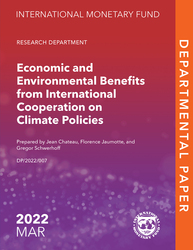
Economic and Environmental Benefits from International Cooperation on Climate Policies
This paper discusses and analyzes various international mechanisms to scale up global action on climate mitigation and address the policy gap in this area.
READ MORE...
Volume/Issue:
Volume 2022
Issue 007
Publication date: March 2022
ISBN: 9781616358303
$20.00
Add to Cart by clicking price of the language and format you'd like to purchase
Available Languages and Formats
| English |
Topics covered in this book
This title contains information about the following subjects.
Click on a subject if you would like to see other titles with the same subjects.
Taxation - General , Environmental Economics , Environmental Conservation and Protection , Public Policy- Environmental Policy , climate policy , border carbon adjustment , international coordination , global minimum carbon prices , ICPF scenario , carbon price floor agreement , B , policy scenario overview , baseline emission projection , GDP cost , Greenhouse gas emissions , Climate policy , Climate change , Global , Africa , East Asia , Caribbean
Summary
This paper discusses and analyzes various international mechanisms to scale up global action on climate mitigation and address the policy gap in this area. Despite the new commitments made at COP 26, there is still an ambition and a policy gap at the global level to keep temperature increases below the 2°C agreed in Paris. Avoiding the worst outcomes of climate change requires an urgent scaling up of climate policies. Recent policy proposals include the idea of common minimum carbon prices, which underlie the IMF’s international carbon price proposal (Parry, Black, and Roaf 2021) and the climate club proposal of the German government. While global carbon prices are not a new idea, the new elements are the use of carbon price floors—which allow countries to do more if they wish—and the differentiation of carbon price floors by level of development. In the absence of international coordination, countries with ambitious climate policies are considering introducing a border carbon adjustment mechanism to prevent domestic producers from being at a competitive disadvantage due to more ambitious domestic climate policies. An interesting question from the global perspective is whether border carbon adjustment would deliver substantial additional emissions reductions or incentivize other countries to join a carbon price floor agreement.
Copyright © 2010 - 2025
Powered by:
AIDC



